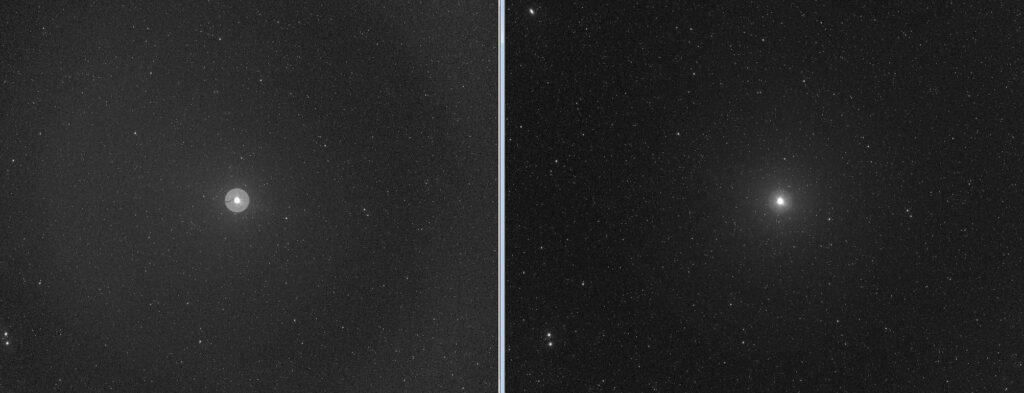Our customer Andreas Bringmann was one of our first testers of the new CMOS-optimized Baader Ultra-Highspeed F/2 filters. The all new f/2 Ultra-Highspeed Filters not only lead to amazing images but even enabled the photographic proof of the newly discovered planetary nebula StDr13, check out the detailed test review.
Now Mr. Bringmann had the opportunity to test the new CMOS optimized Baader 5.5nm H-Beta filters:
First of all, I would like to thank you very much for allowing me to test the new Baader filters and I can report that the new CMOS-optimized 5.5nm H-beta filter works photographically perfectly even at f/1.9!
Andreas Bringmann, www.astrobin.com/equinoxx/
The new CMOS-optimized 5.5nm H-beta filter was compared against the old 8.5nm H-beta filter from 2014, which was in Mr. Bringmann's possession.
Read the entire test report by Mr Bringmann here:
Notes about the test:
The images were taken with my Baader roof observatory with the following equipment:
- Celestron C11 Edge HD + Hyperstar v4 @ f/1.9
- 10micron GM3000 HPS without guiding
- ZWO camera ASI 6200 MM Pro @ -15°C
The test shots are JPGs of the unprocessed raw data as they come out of the camera. Darks, flats and FIT files are available on request.
The tests were carried out on 02 September 2021. The night was practically moonless. Stars of 5 magnitude were visually well visible.
Test images:
- The Sadr region in the constellation Swan with the 2.2 mag bright star gam Cyg Sadr was used to compare the halo situation and the contrasts.
- The 0 mag bright star alp Lyr Vega, which was exposed up to saturation, can be used to study the halo situation in extreme cases.
Pretty Picture:
„Sard region: the first test of the new H-beta filter (5.5nm) – CMOS-optimized“:
https://www.astrobin.com/htvgqr/
https://www.astrobin.com/full/htvgqr/0/
https://www.astrobin.com/full/htvgqr/0/?mod=&real=
https://www.astrobin.com/htvgqr/B/
1. The Sadr region with the approximately 2.2 mag bright star gam Cyg Sadr in the centre
gam Cyg Sadr , Crop:

gam Cyg Sadr, 600s exposed on C11 Hyperstar, left the old 8.5nm H-beta filter from 2014 right new Baader CMOS-optimized 5.5nm H-beta filter
2. alp Lyr Vega:

alp Lyr Vega, 600s exposed on C11 Hyperstar, left the old 8.5nm H-beta filter from 2014 right new Baader CMOS-optimized 5.5nm H-beta filter
Pretty Picture in SII, Ha, OIII, Hb + LRGB:
Technical image data:
https://www.astrobin.com/htvgqr/
As a suitable test object I decided for the Sadr environment, because the following list for nebula filters marks this region as "good H-beta filter effect": http://www.astro-okulare.de/nebelliste.htm
This image was exposed in the Hubble palette enriched by the H-beta line. In the image processing I tried to assign the OIII data more to the turquoise colour and the H-beta data more to the blue colour. The stars were exposed separately as LRGB.
 In the following GIF animation (see also on the right) you can also view the individual narrowband channels, the sequence is described on the website:https://www.astrobin.com/htvgqr/B/
In the following GIF animation (see also on the right) you can also view the individual narrowband channels, the sequence is described on the website:https://www.astrobin.com/htvgqr/B/
In the meantime I was able to capture more pretty pictures with the new 5.5nm H-beta filter and published them on astrobin:
More details on:
https://www.astrobin.com/hrlduh/
https://www.astrobin.com/full/hrlduh/0/
https://www.astrobin.com/full/hrlduh/0/?mod=&real=
 2. Elephant Trunk Nebula in SHaOHb-LRGB
2. Elephant Trunk Nebula in SHaOHb-LRGB
More details on:
https://www.astrobin.com/3uuork/
https://www.astrobin.com/full/3uuork/0/
https://www.astrobin.com/full/3uuork/0/?mod=&real=
Summary:
The new CMOS-optimized 5.5nm H-beta excites because: When a halo becomes brighter than the actual signal, EBV becomes a matter of luck. The reconstruction of the signal under the halo becomes a subjective assessment.
With the new CMOS-optimized 5.5nm H-beta filter, the halos practically do not interfere any more, and "halo remnants" on very bright stars can easily be removed during EBV.
The contrast has now reached an excellent level. Photographically, the new filter delivers such high-contrast data even at f/1.9 that one could believe it was H-alpha data. Compared to the old H-Beta filter a quantum leap!
Many kind regards, also to the filter people and to the whole Baader team.
Andreas Bringmann











